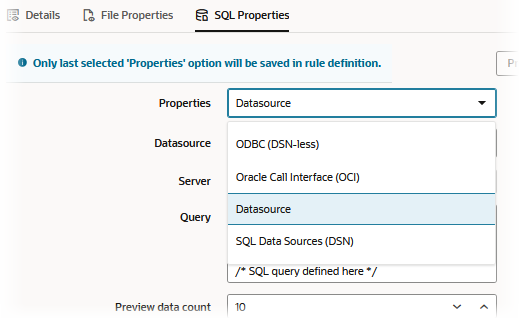Overview of SQL Properties in Rules
Design Essbase load rules with SQL Properties to extract data from a relational database using a SQL query, when your source of data is in an external system such as an RDBMS.
SQL-based loads extract data from a relational database using a SQL query, and load it into Essbase using your defined rule.
Before you start, identify whether your access to the external source is based on:
-
a predefined connection and Datasource established in Essbase
-
a connection string to your external source of data
-
ODBC drivers configured on Linux or on Windows
Once you know the above information, log in to the Essbase web interface and start here to define SQL-based connectivity for your load rule.
-
Open an existing rule or create a new one (see Access and Edit Rules, Create New Dimension Build Rule, or Create New Data Load Rule).
-
Click Source Properties.

-
Click SQL Properties.
-
Identify which of the following Properties categories best applies to your source data.

If your connectivity has been predefined using a connection and Datasource established in Essbase, choose Datasource, and see Access External Data Using a Connection and Datasource.
If your connectivity depends on ODBC drivers configured on the Essbase server, choose ODBC (DSN-less) or SQL Data Sources (DSN), and see Access Data Using ODBC Connectivity.
If your connectivity depends on a connection string that includes
OCI, choose Oracle Call Interface (OCI), and see Access Oracle Database Using Oracle Call Interface.